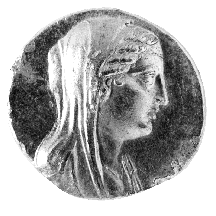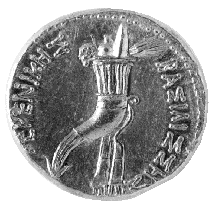



(57) Egypt, Ptolemy III Euergetes - AV octodrachm, c. 246-221
B.C., 27.81 g. (inv. 91.099).
Obverse: Diademed and veiled head of Berenike II r., wearing necklace.
Reverse: Cornucopia bound with diadem; ![]()
![]() : of Queen
Berenike.
: of Queen
Berenike.
Provenance: Numismatic Fine Arts, 1980.
Bibliography: J. Svoronos, Ta Nomismata tou Kratous ton Ptolemaion
2 (Athens 1904) 1113, pl. 35.1; O. Mørkholm, Early Hellenistic
Coinage from the Accession of Alexander to the Peace of Apamea (336-188
B.C.) (Cambridge 1991) 106.
Ptolemy III Euergetes (Benefactor) carried on successful military campaigns
(see no. 58) that brought new wealth into Egypt, resulting in the minting
of octodrachms and other gold denominations and a return to the Attic weight
standard, which had not been used in Egypt for over sixty years. The most
common type on the obverse of the octodrachms was a portrait of his wife,
Berenike II of Kyrene. Berenike's marriage to her cousin was politically
significant, since it had brought Kyrene, which had been lost by Ptolemy
II, back under Egyptian control. Upon the death of her husband, she became
joint ruler with her son, Ptolemy IV, who had her murdered.
Coin portraits of queens were common in Hellenistic Egypt, where women had
higher status than elsewhere in the ancient world and were often influential.
Berenike is depicted with the royal diadem and a veil. The fruit-filled
cornucopia bound with the royal diadem of the reverse is a symbol of abundance
and prosperity often depicted on the coins of agricultural Egypt.
K.J.B.



All contents copyright (c) 1996.
Lawrence University
All rights reserved.